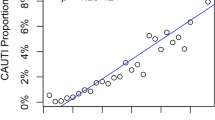Abstract
Objective
To determine the risk factors for catheter-associated urinary tract infection in a polyvalent intensive care unit (ICU).
Design
Prospective cohort study.
Setting
Sixteen-bed polyvalent ICU in a French university hospital.
Interventions
Prospective patient surveillance of patients included in two successive studies of two urine drainage systems.
Main outcome measures
Bacteriuria occurrence in 553 ICU patients requiring a bladder catheter for longer than 48 h. The following variables were analyzed as possible risk factors: age, sex, severity score at admission, diagnosis on admission, duration of bladder catheterization, length of ICU stay, prior exposure to antibiotics, and system of urine drainage.
Results
The frequency of catheter-associated bacteriuria was 9.6%. From the multivariate analysis, five independent risk factors were determined: female sex, length of ICU stay, use of an antimicrobial therapy, severity score at admission, and duration of catheterization.
Conclusion
In our study, the drainage system did not influence the occurrence of bacteriuria. To decrease the rate of catheter-associated bacteriuria in polyvalent ICU patients, removal of the bladder catheter must be performed as soon as possible.
Similar content being viewed by others
References
Rosser CJ, Bare RL, Meredith JW (1999) Urinary tract infections in the critical ill patient with a urinary catheter. Am J Surg 177:287–290
Garibaldi RA, Burke JP, Dickman ML, Smith CB (1974) Factors predisposing to bacteriuria during indwelling urethral catheterization. N Engl J Med 291:215–219
Platt R, Polk BF, Murdock B, Rosner B (1986) Risk factors for nosocomial urinary tract infections. Am J Epidemiol 124:977–985
Saint S, Lipsky BA (1999) Preventing catheter-related bacteriuria. Should we? Can we? How? Arch Intern Med 159:800–808
Tissot E, Limat S, Cornette C, Capellier G (2001) Risk factors for catheter-associated bacteriuria in a medical intensive care unit. Eur J Clin Microbiol Infect Dis 20:260–262
Leone M, Garnier F, Dubuc M, Bimar MC, Martin C (2001) Prevention of nosocomial urinary tract infection in ICU patients. Comparison of effectiveness of two urinary drainage systems. Chest 120:220–224
Leone M, Garnier F, Antonini F, Bimar MC, Albanèse J, Martin C (2003) Nosocomial urinary tract infection in intensive care unit: comparison of effectiveness of two urinary drainage systems in intensive care unit. A prospective, randomized clinical trial. Intensive Care Med (in press)
Le Gall JR, Lemeshow S, Saulnier F (1993) A new Simplified Acute Physiology Score (SAPS II) based on an European/North American multicenter study. JAMA 270:2957–2963
REANIS (1994) Prevention of nosocomial urinary tract infections In: REANIS (ed) Guidelines for the prevention of nosocomial infections in intensive care unit. Arnette, Paris, pp 40–52
Garner JS, Jarvis WR, Emori TG, Horan TC, Hughes JM (1988) CDC definitions for nosocomial infections. Am J Infect Control 16:128–140
Schaberg DR, Weinstein RA, Stamm WE (1976) Epidemics of nosocomial urinary tract infection caused by multiply resistance gram-negative bacilli: epidemiology and control. J Infect Dis 133:363–366
Hyams KC (1987) Inappropriate urine cultures in hospitalized patients receiving antibiotic therapy. Arch Intern Med 147:48–49
Johnson JR, Roberts PL, Olsen RJ, Moyer KA, Stamm WE (1990) Prevention of catheter associated urinary tract infection with a silver oxide-coated urinary catheter: clinical and microbiological correlates. J Infect Dis 162:1145–1150
Stamm WE (1990) Catheter-associated urinary tract infections: epidemiology, pathogenesis, and prevention. Am J Med 91[Suppl 3B]:65–71
Ferguson NR, Galley HF, Webster NR (1999) T helper cell subset ratios in patients with severe sepsis. Intensive Care Med 25:106–109
Platt R, Polk BF, Murdock B, Rosner B (1983) Reduction of mortality associated with nosocomial urinary tract infection. Lancet 1:893–897
Bryan CS, Reynolds KL (1984) Hospital-acquired bacteremic urinary tract infection: epidemiology and outcome. J Urol 132:494–498
Author information
Authors and Affiliations
Corresponding author
Additional information
An erratum to this article can be found at http://dx.doi.org/10.1007/s00134-003-2080-9
Rights and permissions
About this article
Cite this article
Leone, M., Albanèse, J., Garnier, F. et al. Risk factors of nosocomial catheter-associated urinary tract infection in a polyvalent intensive care unit. Intensive Care Med 29, 1077–1080 (2003). https://doi.org/10.1007/s00134-003-1767-2
Received:
Accepted:
Published:
Issue Date:
DOI: https://doi.org/10.1007/s00134-003-1767-2




